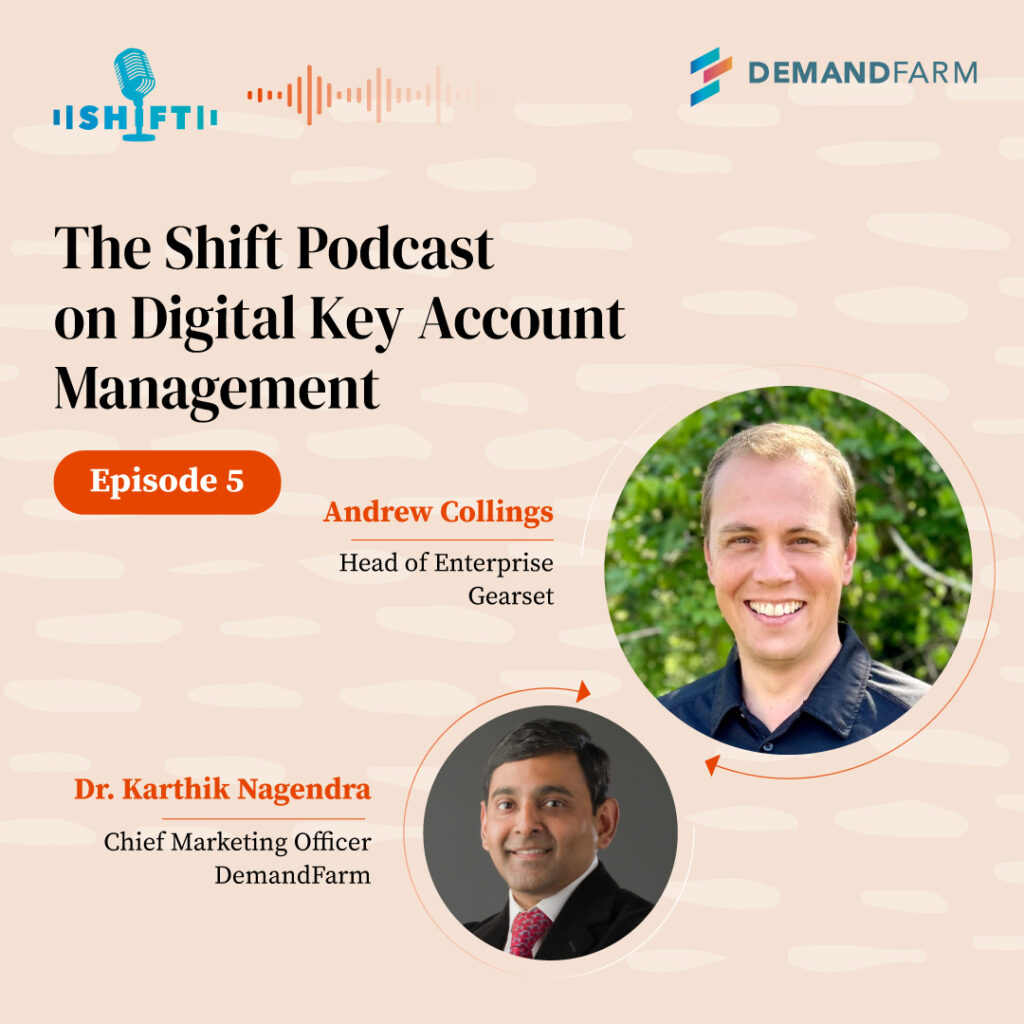Case Study: 2x Improvement in Customer Relationships with Org Chart

A company in the Healthcare sector within the IT services industry was unable to strengthen relationships with their customer account contacts and leverage influences within the account. This led to a dip in their sales and business performance. DemandFarm’s Org Chart helped them double their customer relationships to enhance their sales efficiency. Download this Case study to learn more about how the Org Chart was an effective solution. Read the Case Study here
Case Study: Fintech Company Enhances Sales Performance by 12% with Account Planner

A Fintech company in the Information Technology and Services industry was facing several key challenges in their sales operations including lack of clarity on the current pipeline and lack of account knowledge from just Salesforce. DemandFarm’s Account Planner helped the company move beyond their CRM to improve their sales performance by 12% and make the company a success story. Learn more about the solutions by DemandFarm’s Account Planner in boosting sales performance by downloading the Case Study. Read the Case Study here
Case Study: 80% Business Retention with Org Chart for this Business Consulting firm!

A large-sized, leading IT and Business Consulting firm was facing difficulties in managing their enterprise accounts. Some challenges include: -> Inability to manage key contacts for their enterprise accounts -> Inability to identify key stakeholders -> Zero visibility into connections within key accounts Learn more about DemandFarm’s Org Chart and relationship mapping tool solutions for Business Consulting in this Case Study. Read the Case Study here
Case Study: Ed-Tech Company Maximizes Efficiency by 50% with Data-driven Account Transfers

An Ed-Tech company from the Information Technology and Services industry was facing problems with their sales process including lack of visibility on account performance and a non-standardized account planning process. DemandFarm’s Account Planner solutions contributed to a 50% reduction in time and effort for account handovers. Learn more about the implementation and benefits of DemandFarm’s solutions in this downloadable Case Study. Read the Case Study here
Case Study: Accelerate Deal Closures by 1.5 times with DemandFarm’s Account Planning Solutions

A company in the hospitals and healthcare industry faced 5 major challenges including -> Lack of visual representation of growth opportunities -> Absence of structured sales approach -> Lack of detailed insights -> Difficulty in handling major deals in Salesforce -> Lack of knowledge on supporters within customer network DemandFarm’s Advanced Account Planner and Opportunity planner addressed these challenges and more… Get to know how by downloading this Case Study. Read the Case Study here
DemandFarm named as G2 Leaders in Best Support & Easiest To Do Business With in the Fall, Summer, Spring & Winter 2023 Reports

New York, Sep 22, 2023: DemandFarm continues to stand out in Digital Key Account Management space. Review site G2.com has recognized DemandFarm consecutively in the Fall, Winter, Spring and Summer 2023 report. This is a sign of DemandFarm’s continued leadership in the B2B Digital Key Account Management space. DemandFarm has been awarded the ‘Best Support’ badge for excellence in customer satisfaction across its 25000+ user base. DemandFarm has consistently scored with above-average ratings on its Quality of Support provided (95% against an average of 91%) and Ease of doing business with ( 98% against an average of 93%). 89% of users are likely to recommend DemandFarm to others G2 is a review site that enables organizations to find the appropriate software and services to satisfy their needs by accessing over 1 million reviews. To read more reviews about DemandFarm, check out the G2 website here: https://www.g2.com/products/demandfarm/reviews#reviews
The Shift Podcast on Digital Key Account Management: Andrew Collings, Head of Enterprise at Gearset

When working with large businesses and going outbound, being deliberate about the planned approach provides structure to your organization’s interactions. Recently B2B selling has almost completely turned digital. With ever-growing, larger buying groups in this digital age of B2B selling, what are some factors that go into it; challenges encountered and benefits gained? In the fifth episode of The Shift Podcast on Digital Key Account Management, Andrew Collings (Head of Enterprise at Gearset) and Dr. Karthik Nagendra (Chief Marketing Officer at DemandFarm) discuss adapting your organization to this changing, digital B2B environment. Andrew shared some of the crucial factors he considered when shifting to a digital approach to keep track of his key accounts. This includes having a tool that :- 1. Integrates into Salesforce without requiring external software to manage accounts 2. Represents data visually and is easy to use for faster adoption 3. Accommodates custom needs accurately and works around that 4. Shows all information in one place without having islands of data
The Need to Spearhead Change in Digital Key Account Management

As Key Account Management practices head towards a virtual direction, technology takes the center stage. Account Managers and Sales Leaders have to accommodate changing customer trends and expectations. DemandFarm’s Dr. Karthik Nagendra – Chief Marketing Officer had a one-on-one conversation with Jennifer Smith-Byers – VP Client Services, from TaskUs on the journey to Digital Key Account Management. The following sections cover some of the inputs from the discussion about the factors, challenges and advantages that arise from transitioning into a digital era of Key Account Management. Increasing Revenues from Key Accounts is the need of the hour! In the post-pandemic digital age, the main priority for organizations has been increasing the revenue from their key accounts. ‘Digital’ is at the core of all functions and that has invariably transmitted to the B2B space and Key Account Management as well. For Jenny Smith-Byers, “Any company that’s able to secure large accounts need to continue to foster those accounts not only in order to grow them, but also to maintain them and those are key to our success.” Continued growth as a business involves retaining key accounts since that is where most of the revenue for an organization comes from. Large accounts are very complex and to ensure continuing business from them requires a strategic approach to handling those accounts. Traditionally, account plans were created once a year and were reviewed across the executive team in the account or product side. But now-a-days, plans change very quickly. When PPTs and Excel Sheets were the norm before, updates were also irregular. Digital Account Planning tools these days, however, encourage us to view Key Account Management as a dynamic rather than a static process. Factors to consider when making a shift to digital key account management tool Ensure you are at the right maturity level Have the discipline to fully leverage a tool Executive buy-in across the organization to ensure adoption Need to keep a dynamic planning approach Choose the right champions to drive transformation Ability to integrate into your existing tools Ensure you get the right training and support across the organization Choose the right partner to advocate for you and help you build strategic relationships as you use the digital tool Checklist: How to Select the Ideal Digital Account Planning Tool Challenges Faced With any kind of transformation within an organization, there are a bunch of challenges to be encountered. When shifting to Digital Key Account Management as well, there are a few hurdles to overcome. 1) Client Face Time Think about the impact on customer/client face time & ensure more internal steps or processes aren’t being added is a major concern. This could pull away the account team from spending valuable time building relationships. 2) Integration Integration into other business tools used by your organization, particularly financial tools. You need to be able to get real-time updates of where you’re at in terms of revenue tracking against your plan and budget for the year. 3) Getting the right early adopters It takes time to change things if one is used to a way of doing things. To show the value of adopting a new digital ecosystem and setting aside time to get everything set up is a challenge. How does one go about championing a change to Digital Key Account Management? For Jenny, there are three main criteria that go into championing the change to Digital KAM. 1) Aligning with your organization: Existing tools, and language used in the daily life of the organization might be different from the standard. So ensuring that the requirements were aligned before implementing was crucial. Aligning with previously existing systems also reduced naysayers when it comes to adoption of a new digital Key Account Management tool. 2) Getting a team of ‘Advocates’: Having a team of beta testers or advocates who have tried out the tool will make it easier to roll it out to the entire organization. Any sort of issues can be cleared up in the trial stages and these super users will act as champions to help others get trained in shifting to a digital key account management practice. 3) Support from Senior Leadership: Support from senior leadership is critical for efficient change management to ensure that transition to a digital ecosystem runs smoothly. Download: Change Management Guide for Sales Leaders to Implement Digital Account Management Software Advantages of taking a digital approach to Key Account Management For Jenny, 5 huge advantages stand out from adopting a digital KAM framework for Account Planning. 1) Consistency: There is consistency and straightforwardness when it comes to updating account plans. A real understanding of the client, their relationships, who the buyers are and what drives their decisions is available easily. 2) Adaptability: To be able to quickly adjust account plans is a huge benefit of digital KAM tools. It becomes easier to fit what your client is doing and the innovation that comes with a digital KAM tool also makes account plans more effective. For Jenny, having a digital tool simplifies a lot of processes and someone new coming to the organization can pick up an account quickly as it is already established. “For me it was a kind of AHA moment. We had a new Chief Operating Officer who joined the company and we wanted to introduce him to the key accounts across the organization. We didn’t didn’t do anything other than leverage DemandFarm. We used the Grandstand feature, walked them through the accounts – these are key people we meet with; these are our strengths, opportunities, threats, weaknesses; these are the areas we’re going after… We used everything in the tool and there was no extra prep. There wasn’t anything that caused us to spend a lot of extra time preparing charts for a new executive,” says Jenny. 3) Strategic thinking about Client Relationships Having an integrated, simple approach gives rise to a step-by-step flow thinking or strategic thinking about client relationships. Aligning focus and building on growth opportunities then gets standardized
The Shift Podcast on Digital Key Account Management: Ethan Trifari, Director at CapTech Ventures, Inc

The digital world is now more connected than ever to every action and transaction in our daily lives. In this new world, the priority for companies lies in creating and implementing a digital account strategy that can be utilized to grow. In the fourth episode of The Shift Podcast on Digital Key Account Management, Ethan Trifari, Director at CapTech Ventures, Inc and Karthik Nagendra, Chief Marketing Officer at DemandFarm discuss the importance of digital key account management in achieving the best customer relationship strategy. Ethan shared some of his key motivations for transitioning to digital Key Account Management ! 1. To ensure a data-driven approach to strategy and account management 2. To uplift workforce by making account management easier 3. To enhance tooling & infrastructure to do the best work possible 4. To find a way to leverage collected data to make better decisions 5. To have a better customer relationship management strategy
Shift to Digital Key Account Management with Anees Merchant

As Key Account Management practices head towards a virtual direction, technology takes the center stage. Account Managers and Sales Leaders have to accommodate evolving customer trends and expectations. DemandFarm’s Dr. Karthik Nagendra – Chief Marketing Officer had a one-on-one conversation with Anees Merchant – EVP Global Growth, from Course5i on the Digital Key Account Management journey. Course 5i is a pure-play data analytics and insights company that focuses on helping organizations drive digital transformation using artificial intelligence (AI), advanced analytics, and insights. The following sections cover some of the inputs from the discussion with Anees Merchant about technology as a key enabler, leveraging multiple stakeholders, transitioning into a digital era of Account Management and much more. Digital Key Account Management – why is it needed now? The optimum process to drive sales and client organization involves account management principles and practices. It is important to not only have a large set of accounts within an organization, but also to have good value accounts. When delving deeper into key accounts, understanding their innate capabilities is needed. Account management institutes a process and governance within the organization not only with the sales or client-facing teams, but also with the entire organization. This sort of Key Account Management process helped scale up Key Accounts. Digital Key Account Management in particular has transformed interactions with clients and how to build relationships at a larger scale. In addition, the digital Key Account Management space is also one that is continually evolving. According to Mr. Merchant, “Buyers have changed their behaviors in a significant way. There are many people now who can participate in the buying decision which was never the case before.” Day by day, it is becoming vital for organizations to leverage technology to enable key account management processes. Challenges when adopting Digital Key Account Management “We also had our own share of learning challenges along the way. At the end of the day we work with humans and we work with human behaviors and it’s hard to change,” says Mr. Merchant. Here are a few challenges that were encountered when shifting to Digital Key Account Management within Course5i. Building processes of governance and reporting so that employees feel that Key Account Management is a part of their job, and not just an additional burden. Integrating finance organizations within this process. Inculcating a sense of transparency into the process so that visibility into industry benchmark and company benchmark fosters growth. Making the Key Account Management process more real-time as an analytics and AI company. Benefits of adopting Digital Key Account Management The following are some of the benefits that have come from shifting to a Digital Key Account Management process. 1. Marquee Accounts Every organization has certain marquee accounts, long tails and recently acquired accounts within key industries. After adopting digital Key Account Management practices, sales leads are able to identify patterns between these accounts and between different verticals that can be leveraged. Marquee accounts are getting bigger and long tails are driving better growth for the company as well. 2. Enhanced customer centricity Integrating digital tools into the Key Account Management process of an organization has the ability to enhance understanding of the customer for the sales team. The ability to look at an account from various facets and various departments in an organization gives a real insight. Shifting to Digital Key Account Management enables scaling up accounts in this manner. Things to keep in mind when adopting a Digital Key Account Management process 1. Get the process right: Think before you act on how to go about before you bring on the technology element. It is crucial to understand, plan and map out how you will be able to go ahead and drive revenue goals. 2. Transparency: Involve people within the organization as part of the process from the beginning itself. This helps unburden the process of transition. Additionally, they can see the impact a digital Key Account Management system would make and how it can improve the overall functioning of the organization. 3. Integration: It becomes much more difficult to drive a piece of technology if it does not seamlessly integrate within the existing ecosystem. The transition to adopting a Digital Key Account Management becomes much easier when it can gel with your existing CRM platform. 4. Do a pilot: Depending on the size of your organization, doing a trial of the Key Account Management processes with a few accounts can bring a deeper understanding when it comes to the hindrances and value that you are able to incorporate. It is critical to keep all these aspects in mind when evaluating the different platforms for transitioning into digital Key Account Management. This is what makes DemandFarm’s Org Chart and Account Planner stand out. They integrate without any hitches to your CRM platform. Listen to the complete conversation with Anees Merchant below.